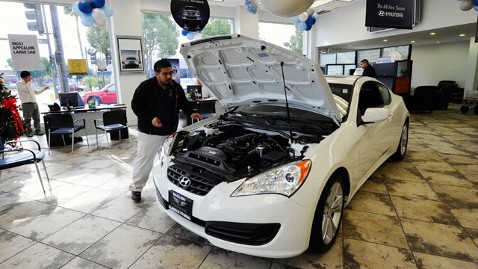Best New Car Deals on Busiest Shopping Week of Year

(Kevork Djansezian/Getty Images)
Along with retailers who make 10 to 15 percent of their holiday sales the week after Christmas, car dealers are likely to have one of their busiest weeks too.
Alec Gutierrez, senior market analyst at Kelley Blue Book, said December sales tended to be either the strongest or close to the strongest for car dealers for two reasons.
Many consumers are awaiting better deals on 2012 models, some of which began selling in September, while others are waiting for 2011 models to drop in price. Meanwhile, dealers and manufacturers are not only trying to meet their monthly goals but trying to sell their cars from 2011 to make room for the new models.
"So if they're running short of their goals, they will add additional incentives to sell their products," such as increased cash incentives or cash rebates with attractive financing, Gutierrez said. "Dealers will try to get a better price and negotiate with manufacturers for new cars also."
Car deals in 2011 differ from those in 2010, because supplies are slightly tighter, in part because of supply disruption after Japan's earthquake and tsunami.
"There isn't necessarily a limited capacity, but manufacturers and dealers do not have the excess numbers that they've had to unload in previous years," Gutierrez said.
While Gutierrez said he has not seen as many cash incentives and rebates this year, especially for Japanese cars, he said financing - often at zero percent - is widely available and will continue to be offered through 2013. The Federal Reserve said it would maintain low interest rates through the federal funds rate through 2013, which affects auto loan rates.
Only new-car dealers, through their manufacturers' finance companies, can offer interest-free loans on new cars and trucks, according to Charles Cyrill, director of public relations at the National Automobile Dealers Association.
This year there are no major federal tax incentives for car purchases, such as 2009's Cash for Clunkers, except for a $7,500 tax credit for the all-electric Nissan Leaf and Chevy Volt. But states may offer various tax incentives for car purchases.
The more attractive incentives tend to be limited to 2011 models, and full-size trucks and SUVs, which are in more abundant supply. Gutierrez said he had seen "solid incentives" on trucks, such as the Ford F-150 and Chevy Silverado. The Toyota Tundra offers a cash rebate, and the 2011 Chevrolet Malibu is available with a $3,500 cash rebate, which is "pretty sizable," said Gutierrez.
Manufacturers and dealers are trying to entice customers to buy before the Malibu's 2013 redesign, which is expected at the end of 2012, he said. The 2012 Malibu has a cash rebate of $2,500.
"It's not as attractive as the rebate for the 2011 model, but you can see they're trying to move vehicles," said Gutierrez.
But fewer cash incentives does not seem to stop car shoppers.
Car sales will likely exceed 1.2 million units this month, putting December on pace to be the strongest month of the year, according to Gutierrez. December was the strongest month last year as well. In 2010, sales in December totaled 1.15 million units, he said.
WardsAuto expects light-vehicle U.S. sales volume this month to be about 8 percent higher than December 2010. The forecasted sales volume for the year is 13.4 million compared with 12.4 million a year ago on a seasonally adjusted annual rate.
Car inventory is also noticeably tighter this year. Overall supply is down to 47 days from 55 days last December, according to WardsAuto. Manufacturers prefer to have a 60-day supply of cars ready to sell. U.S. carmakers GM, Chrysler and Ford had an 80-day supply of 2011 and 2012 vehicles as of Dec. 1, according to Automotive News. Gutierrez called the recent figures "healthy" and "abundant." Last year, domestic manufacturers had a 74-day supply.
In contrast, Japanese manufacturers now have a 48-day supply, which Gutierrez said is on the low end, related to supply disruptions in Japan. Korean manufacturers had a 30-day supply as of Dec. 1.
"Hyundai and Kia had a phenomenal year given nice redesigns," Gutierrez said.
At the same time last year, Japanese manufacturers had a 66-day supply, while Korean makers had a 43-day supply.
Supplies also seem tighter in the used-vehicle market.
According to the NADA's Used Car Guide, used vehicle values are up significantly in 2011, which means trade-in values may be higher. The average value of a three year-old vehicle increased by 5 percent compared with 2010.
That's one reason why now is a good time to buy a new car or truck, Cyrill said.
"Consumers have equity built into the vehicles they currently own," he said. "The money they receive for a trade-in at the dealership can be used as a down payment on a new vehicle."